1. Ross Detwiler’s latest hits.
Two months ago, I wrote about Ross Detwiler, the most extremely low BABIP hitter in baseball, and the artist behind this spray chart:
Since then, Detwiler has produced two base hits, neither of which was a home run and thus both of which will be credited to his BABIP, which is now .127. That’s only the fourth lowest among active players, better than the BABIPs of Tommy Hanson, Mark Buehrle, and Ramon Ortiz (which is to say, very soon to be the third lowest among active players). Let's study this accomplishment via endlessly repeating videos!
Before the first swing in question
The Nationals TV broadcast, discussing Anthony Rendon, focuses its cameras on Anthony Rendon. Rendon has not done anything interesting in the previous few minutes and would have no reason to think he’s on camera, other than the paranoia that would infect many human beings when they are on camera as often as baseball players are. Rendon pokes a finger toward his nose. Simultaneously, Ian Desmond happens to look up, see the camera pointed in at the dugout, glance to his side and see that Rendon has been caught digging for boogies.

What will Desmond do?
a. Ignore the situation. Just a boogie. Who cares?
b. Point at Rendon and mug for the camera. El oh el at the rookie.
c. Inform Rendon that he’s being busted.
d. Walk to the camera and drape a towel over it, reclaiming the dugout for himself and his team.
Answer:

C! Nice guy Ian Desmond comes through again.
The first swing in question
Detwiler lines a single into right field. I am Jack’s complete lack of surprise.

Michael Cuddyer thinks about it. One of Detwiler’s previous hits involved a right fielder throwing to first, and this one probably should have, too.

I got Detwiler at 4.8 seconds to first, and Cuddyer picking the ball up at 2.8 seconds. Maybe not fast enough to get Detwiler, but it certainly would have been close.
After the first swing in question
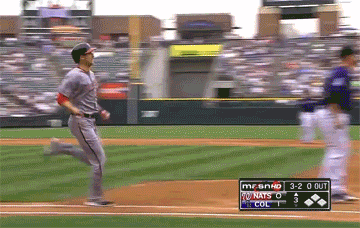

John Hirschbeck: Ho, ho, ho, can you believe he was going to try to throw you out from right field?
Ross Detwiler: smdh
John: That’s not even allowed
Ross: wtf
John: It's like, know your place buddy!
Ross: you're an umpire lol
Before the second swing in question
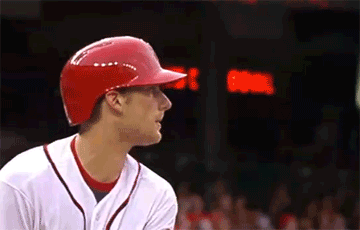
The second swing in question
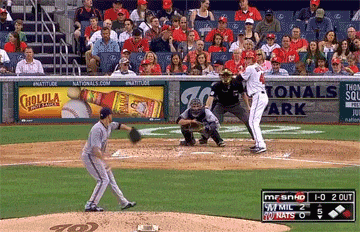
After the second swing in question
It’s like the people around Ross Detwiler have become aware of Ross Detwiler’s offense, and aware that we all (you and me) are talking about it. After this hit, the TV broadcast went through a long series of crowd shots, showing the ecstatic madness sweeping through the stadium. It was the fifth inning. No runs scored on the play.
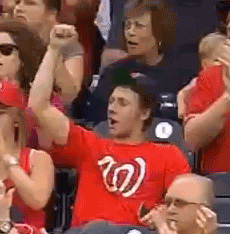





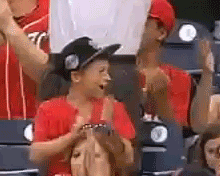

I could have made literally dozens of these.
2. Matt Harvey’s latest matchups against pitchers.
Two weeks ago, I wrote this:
And then let’s say that Matt Harvey is, oh, the fifth-best pitcher in the world. Imagine a movie by the fifth-best director going up in a film festival against a movie by the 10,000th-best director. Imagine the fifth-best jazz trumpeter in the world going up against the 10,000th-best jazz trumpeter in a jazz trumpet off. Imagine, for goodness sakes, the fifth-best pass rusher in the world charging against the 10,000th-best offensive lineman.
So that’s how you get this line, which is what pitchers have done against Matt Harvey this year:
1 for 27, 16 strikeouts, .037/.074/.037
The same day that Detwiler got his infield hit against Milwaukee, Harvey allowed this hit to Randall Delgado:

It came on a 1-0 pitch, and Delgado just reared back and hacked; if the fastball had been up seven inches he’d have had no chance, but it wasn’t. There’s not really anything interesting here, but gotta stick to the framing device. It was interesting to me that, as the ball was sailing over the second baseman, a Mets announcer declared it to be only the second hit ever by a pitcher against Harvey. That’s a pretty random tidbit to just have on hand, unless he read it in an article a few days earlier. So it was interesting to me because I wondered whether he'd read my article. Is that what you wanted to hear? That I’m just that needy? Well there it is.
3. Matt Harvey’s matchup against Ross Detwiler.
So of course when Harvey and Detwiler matched up I'd write about it. I turned it on just in time to see the last pitch of the at-bat, which was this:
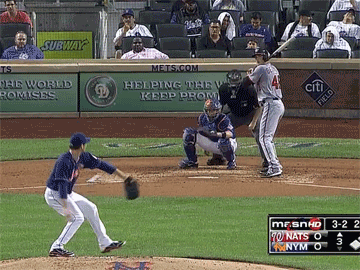
That was on a 3-2 pitch. Why would a pitcher swing at a 3-2 pitch, I wondered. Even if it’s an average-hitting pitcher facing an average pitcher, the odds of a hit couldn’t possibly be as good as the likelihood of a walk—could they?—and I don’t trust a hitting pitcher’s idea of the strike zone. Put Detwiler against Harvey and it seems like a take sign would be the right move.
But there’s a reason we keep track of this stuff, so let’s see.
Since the start of 2012, there have been 652 pitchers who worked a 3-2 count at the plate. They have collectively seen 898 pitches. Of those 898, 299 of them—almost exactly a third—were out of the strike zone, the real strike zone as we define it here. This is important, because it establishes the reason that this might work. Pitchers can throw a strike only two-thirds of the time, even against pitchers, even in three-ball counts. I’m going to assume that there’s very little strategy, from the pitcher’s perspective, at play here. That is, I’m going to assume that the pitchers weren't trying to paint corners, to get the hitters to chase, etc. (Just 25 of the 898 pitches, for instance, were off-speed.) I’m assuming the pitchers were throwing as many strikes as they possibly could. So a hitting pitcher who kept the bat on his shoulder in 3-2 counts would have something like a .333 on-base percentage, and no power. That seems very good!
The second important piece of information is that pitchers are, indeed, very poor at differentiating between strikes and non-strikes. Of the 299 pitches that weren’t in the zone, our hitting pitchers swung at 148 of them, or about half. So we have a) pitchers who aren’t great at throwing strikes and b) hitters who aren’t good at noticing. That’s all the wasted opportunity we’re hoping to capitalize on.
But, of course, there are benefits to swinging. One is that a lot of these dumb swings lead to foul balls, so even though swinging pitchers take only half the balls they see, they actually end up walking far more than half as often as the takers.
And, of course, the pitcher who swings can get hits, and those hits can travel far. The actual results of the 652 plate appearance end up with results not unlike the hypothetical all-take pitcher population, but with a bit more pop and utility:
| Outcome | Swinging Pitchers | Non-Swinging Fantasy Pitchers |
|---|---|---|
| Walk | 145 | 217 |
| Hit | 71 | 0 |
| Reached base | 218 | 217 |
| Extra-bases | 21 | 0 |
| Sac bunt | 6 | 0 |
| Strikeout | 242 | 435 |
| Non-strikeout out | 186 | 0 |
| Double plays | 4 | 0 |
Swinging led to just as many pitchers reaching base, but tacked on 15 doubles, two home runs, a few sacrifice bunts, and a bunch of outs that advanced runners. The only expense was those four double plays, and the baserunning downgrade of a fielder's choice.
Now, this doesn’t necessarily absolve Detwiler, against Harvey. His likelihood of a hit is far worse; his likelihood of chasing outside the zone against a pitcher as good as Harvey is, presumably, greater. But if Detwiler’s decision to swing seems suspect in theory, he sort of came out of it vindicated. That 3-2 pitch that you saw above was actually the fifth 3-2 pitch he saw from Harvey. He fouled off the first four:
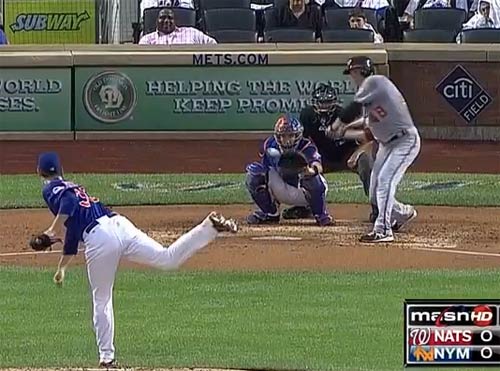


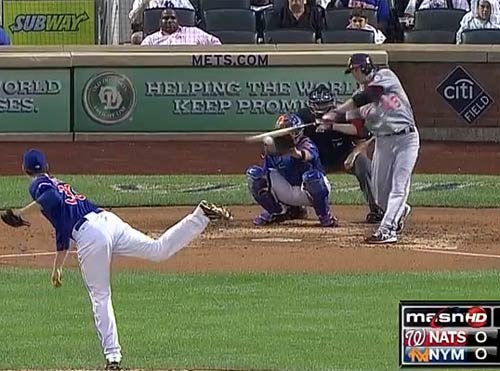
Each of which would have been a strike, but each of which earned him another chance to make Harvey throw something takeably wild. In the end, he was overmatched, but he got a lot of “good at-bat”s when he returned to the dugout.
As for Tim Lincecum swinging on 3-1 against Harvey this week, on the other hand…
Thank you for reading
This is a free article. If you enjoyed it, consider subscribing to Baseball Prospectus. Subscriptions support ongoing public baseball research and analysis in an increasingly proprietary environment.
Subscribe now
Also - I like to think the third-to-last gif of the Detwiler crowd responses is actually his mother, beaming with pride as she says "See?", finally validated after the fan next to her had obviously said something along the lines of, "Oh, your son can pitch a bit, sure - it's too bad he can't hit to save his soul!"
Pitchers, man. Can't throw strikes to save their lives!
I imagine their effective strike zones would be larger, and you'd have a sort of inverse Ted Williams Effect: whereas an umpire might give the benefit of the doubt to a player with a reputation for knowing the strike zone, that same umpire might rule the same pitch a strike against a weak hitter (like a pitcher) because he doesn't trust their batting eye.